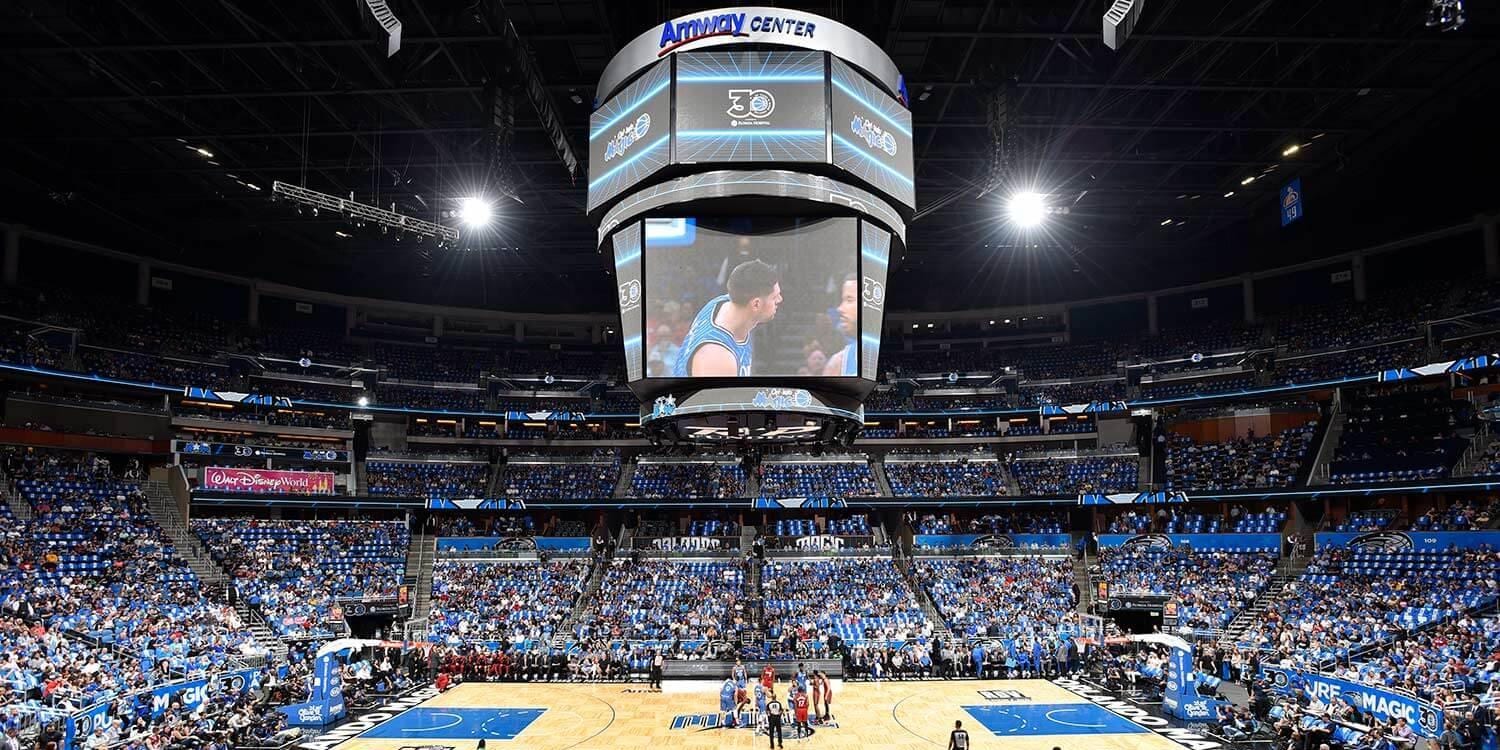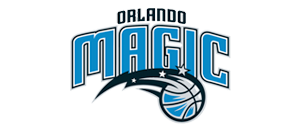- Customer Success Stories
- Orlando Magic

Predictive analytics and AI deliver a winning fan experience

Personalize the fan experience with advanced analytics.

4x revenue jump
from app purchases over previous year
Orlando Magic achieved this using • SAS® Visual Analytics • SAS® Visual Statistics • SAS® for Machine Learning and Deep Learning on Amazon Web Services
The Orlando Magic uses mobile app data and machine learning to personalize marketing campaigns and analyze game data
In the NBA, nothing builds fan loyalty like winning. For the Orlando Magic, crafting an extraordinary fan experience is a close second.
The Orlando Magic is in a league of its own when it comes to using technology to engage fans and drive revenue. Even in the city’s competitive entertainment market, the team is enjoying a seven-figure surge in ticket sales and sponsorships thanks to a new mobile app and a winning analytics strategy.
“We’re leveraging technology as much as we can to enhance the fan experience and build new and improved products,” says Jay Riola, Senior Vice President of Strategy.
Excelling with analytics has become a layup for the Magic. Its analytics journey started in 2010 with the opening of its smart arena, now known as the Kia Center. To test variable ticket prices, the team’s front office acquired SAS Data Management and SAS Analytics. Success followed, with ticket revenue jumping 50 percent in the first season.
Since the 2013-14 season, the Magic’s single game ticket revenue has grown by 91%. Plus, the Magic consistently ranks in the top five in the NBA for single-game tickets sold. Riola attributes much of that success to improved pricing, revenue management and overall marketing strategies driven in large part by analytics.
Today, with its appetite for innovation and a data-driven strategy, the Magic is considered one of the most analytically savvy teams in sports. “Everyone – I mean everyone – uses SAS,” says Riola about the basketball organization.
We're delivering an experience our fans can't find anywhere else.Jay Riola Senior Vice President of Business Strategy Orlando Magic
A fan experience like no other
Say you’re a season ticket holder driving to a Magic game. Fifteen minutes before tipoff, you receive pregame analysis powered by artificial intelligence. A mile from the arena, your phone buzzes with your seat number, which is based on demand for the game. With your Orlando Magic app open, you pay for valet parking and get turn-by-turn directions to your seat. You sit down and order nachos from the app to be brought to your seat, and then redeem a few loyalty points to have the mascot swing by for a selfie with your child.
“Our app is a remote control for the arena experience,” says Riola, who worked with VenueNext to develop the latest version of the team’s app – and connect it to the arena.
Powering the experience is a chain of seamless technology that includes iBeacons. Nearly 20 Apple-designed proximity sensors are located throughout Kia Center, enabling a host of geo-targeted services through the app. Once fans enter the arena, app users receive instant communication including maps, tips on skipping long concession lines and personalized offers for nearby food, beverages and retail.
The app drove significant revenue from customer purchases for the 2018-19 season, including thousands of unique experiences and items offered in the Magic Marketplace. The Magic saw a 120% increase in game day app users for the season, and fan satisfaction scores have increased by 20% regarding the team’s use of in-venue technology.
“There’s a difference between a venue that has technology that lets you do stuff, and the next level of technology that responds individually to each user,” says Anthony Perez, CEO of VenueNext. “And that’s where the Magic, in particular, have done a lot to use data from VenueNext and other sources to drive a dynamic experience, and that is where you get to that next level smart venue.”
Orlando Magic – Facts & Figures
682,000
yearly attendance
100%
of season ticket holders use team app
20%
increase in fan satisfaction with in-venue technology
Personalization takes center court
While a slam dunk of an app is enough to keep some fans engaged, it’s what the Magic does with customer data that puts it in a different league.
The process starts by integrating streaming app data with historical data from more than 2 million customers. Information from 13 source systems – including ticketing, concessions, retail merchandise and app maker VenueNext – is combined into an enterprise data warehouse with close to 200 productionalized target tables. Individuals are then clustered into segments based on their behavior.
At this point, Riola and his team use SAS to model the data and predict what products and services fans are likely to purchase. Personalized offers are then automatically sent to fans via push notifications, website banners and emails.
“We’ve been believers in analytics for a long time,” Riola says. “But we’re getting much more sophisticated in how we use analytics to personalize the fan experience and grow our business.”
A certain segment of fans, for example, will browse jerseys in the app marketplace following a hot performance from one of the Magic’s top players. Using SAS, this interest is scored with predictive models and combined with existing knowledge about these shoppers to display personalized offers for the jersey in the app.
The technology works similarly with season ticket sales. Using a predictive model, the team can anticipate which ticket holders are on the fence about renewing. This enables sales to target at-risk fans through the app with loyalty-building gifts such as free valet parking.
“We continue to outscore the league average in fan experience and improve our year-over-year satisfaction scores,” Riola says. “With SAS, we’re delivering an experience our fans can’t find anywhere else.”
Machine learning examples from The Magic

-
Retention modeling:
Decision trees
The Magic predicts membership renewals for season
ticket members and partial plans using decision tree modeling.
-
Prospect modeling
Random forests
The Magic identifies top ticket sales prospects
among the fan’s customer base using random forest modeling.
-
Ticket demand and sales forecast modeling
Generalized linear models, seasonality
The Magic predicts game-by-game ticket demand to determine ticket pricing and inventory management strategies that inform variable/dynamic pricing and yield management.
-
Revenue optimization
Linear programming
The Magic uses linear programming processes to inform sales mix strategies and to help optimize overall revenue.
Up next: Player analytics
Courtside, the Magic is moving from big data to big results with a cloud deployment of SAS for Machine Learning and Deep Learning on Amazon Web Services. The team stores and analyzes 20 years of data from more than 18 data sources on 100,000 players.
Like every NBA team, the Magic strive to use data to track player fitness, acquire better players, optimize lineups and make other strategic decisions, but data challenges persist. Data volumes are exploding and data complexity is also on the rise. For example, cameras now capture data on the XY location of the ball and all 10 players on the court, 25 times per second.
“Part of our organizational decision to invest in SAS was driven by our basketball analytics department, which is dealing with bigger data than we are on the business side,” Riola says.
Director of Basketball Analytics David Bencs weighs in: “The in-memory processing of SAS will allow us to analyze data more efficiently, and machine learning will help us understand the data at a deeper level. Something that would have required watching hundreds of hours of game film before, now it’s a simple query.”
In addition to using analytics for player acquisitions, lineup rotations and training decisions, Bencs and his team are looking to use analytics for a growing list of more strategic decisions.
“We are at a point where the data that’s available allows us to ask questions that were impossible to answer before,” Bencs explains. “If we can understand the game at a deeper level, it can help us understand why certain games are won or lost.”
Ultimately the team plans to operationalize analytics on both sides of the ball. While Bencs strives to improve team performance by analyzing game data in real time, Riola looks to once again reinvent the fan experience by implementing data-driven technologies like virtual reality and the Internet of Things.
“There’s a whole lot of innovation happening with this team,” Riola says. “There’s no question that analytics will play a key role in guiding our future on and off the court.”
The results illustrated in this article are specific to the particular situations, business models, data input, and computing environments described herein. Each SAS customer’s experience is unique based on business and technical variables and all statements must be considered non-typical. Actual savings, results, and performance characteristics will vary depending on individual customer configurations and conditions. SAS does not guarantee or represent that every customer will achieve similar results. The only warranties for SAS products and services are those that are set forth in the express warranty statements in the written agreement for such products and services. Nothing herein should be construed as constituting an additional warranty. Customers have shared their successes with SAS as part of an agreed-upon contractual exchange or project success summarization following a successful implementation of SAS software. Brand and product names are trademarks of their respective companies.
